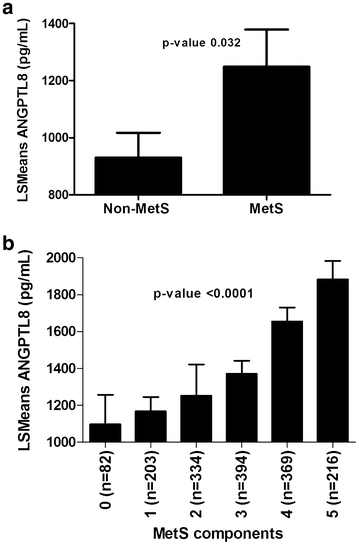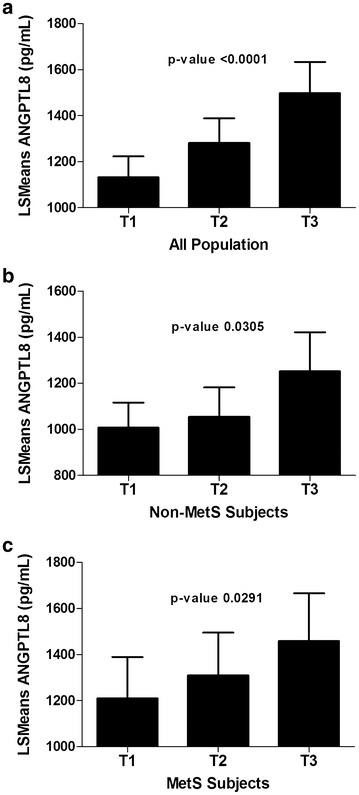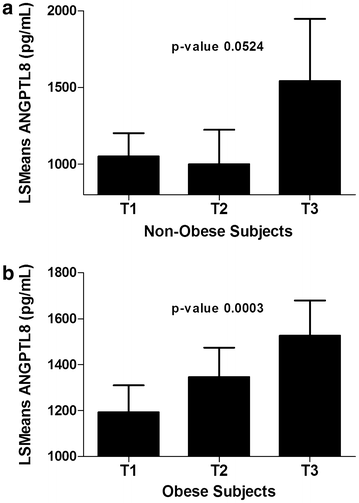Circulating angiopoietin-like protein 8 (betatrophin) association with HsCRP and metabolic syndrome
- PMID: 26850725
- PMCID: PMC4743238
- DOI: 10.1186/s12933-016-0346-0
Circulating angiopoietin-like protein 8 (betatrophin) association with HsCRP and metabolic syndrome
Abstract
Background: ANGPTL8 also called betatrophin is a regulator of lipid metabolism through its interaction with ANGPTL3. It has also been suggested to play a role in insulin resistance and beta-cell proliferation. Based on its function, we hypothesized that ANGPTL8 will play a role in Metabolic Syndrome (MetS). To test this hypothesis we designed this study to measure ANGPTL8 level in subjects with MetS as well as its association with high sensitivity C-reactive protein (HsCRP) level in humans.
Methods: ANGPTL8 level was measured using ELISA in subjects with MetS as well as their controls, a total of 1735 subjects were enrolled. HsCRP was also measured and its association with ANGPTL8 was examined.
Results: ANGPTL8 level was higher in subjects with MetS 1140.6 (171.9-11736.1) pg/mL compared to 710.5 (59.5-11597.2) pg/mL in the controls. Higher levels of ANGPTL8 were also observed with the sequential increase in the number of MetS components (p value = <0.0001). ANGPTL8 showed strong positive correlation with HsCRP (r = 0.15, p value = <0.0001). Stratifying the population into tertiles according to the level of HsCRP showed increased ANGPTL8 level at higher tertiles of HsCRP in the overall population (p value = <0.0001).A similar trend was also observed in MetS and non-MetS subjects as well as in non-obese and obese subjects. Finally, multiple logistic regression models adjusted for age, gender, ethnicity and HsCRP level showed that subjects in the highest tertiles of ANGPTL8 had higher odds of having MetS (odd ratio [OR] = 2.3, 95 % confidence interval [CI] = (1.6-3.1), p value <0.0001.
Conclusion: In this study we showed that ANGPTL8 is increased in subjects with MetS and it was significantly associated with HsCRP levels in different subgroups highlighting its potential role in metabolic and inflammatory pathways.
Figures



References
-
- Ballantyne CM, Hoogeveen RC, Bang H, Coresh J, Folsom AR, Chambless LE, Myerson M, Wu KK, Sharrett AR, Boerwinkle E. Lipoprotein-associated phospholipase A2, high-sensitivity C-reactive protein, and risk for incident ischemic stroke in middle-aged men and women in the Atherosclerosis Risk in Communities (ARIC) study. Arch Intern Med. 2005;165(21):2479–2484. doi: 10.1001/archinte.165.21.2479. - DOI - PubMed
-
- Downs JR, Clearfield M, Weis S, Whitney E, Shapiro DR, Beere PA, Langendorfer A, Stein EA, Kruyer W, Gotto AM., Jr Primary prevention of acute coronary events with lovastatin in men and women with average cholesterol levels: results of AFCAPS/TexCAPS. Air Force/Texas Coronary Atherosclerosis Prevention Study. JAMA. 1998;279(20):1615–1622. doi: 10.1001/jama.279.20.1615. - DOI - PubMed
-
- Rezaianzadeh A, Namayandeh SM, Sadr SM. National Cholesterol Education Program Adult Treatment Panel III Versus International Diabetic Federation Definition of Metabolic Syndrome, Which One is Associated with Diabetes Mellitus and Coronary Artery Disease? Int J Prev Med. 2012;3(8):552–558. - PMC - PubMed
Publication types
MeSH terms
Substances
LinkOut - more resources
Full Text Sources
Other Literature Sources
Medical
Research Materials
Miscellaneous

